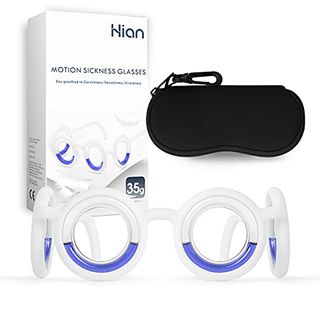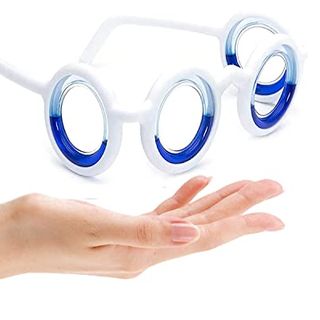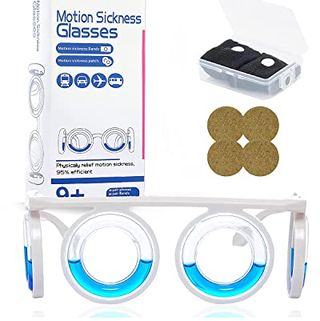- Anti-motion sickness glasses are trending on TikTok, with many users claiming that they help prevent symptoms of motion sickness while traveling by car, plane, train and even on cruise ships.
- Leading eye health experts say that while these glasses are not proven to improve medical symptoms, they are indeed harmless as a low-risk and low-cost option.
- A more effective way to prevent motion sickness may be taking certain over-the-counter medication, as well as making travel arrangements that limit overstimulation of your vestibular system.
If you’re prone to getting carsick, seasick or reaching for vomit bags in the clouds, you already know how miserable motion sickness can be. From the intense waves of nausea to the dizziness, cold sweats and vomiting, it can be enough to turn the fun waiting at your vacation destination into a logistical travel nightmare. And facing these serious symptoms is more common than you might think. In fact, about one in three people are considered highly susceptible to motion sickness.
Thankfully, though, there are several remedies for motion sickness, from prescribed patches to over-the-counter antihistamines. And now there’s a new option you might have not even heard of yet: anti-motion sickness glasses. Manufactured and marketed with promises to help reduce or prevent a myriad of motion sickness symptoms, these glasses are the latest self-help wonder to currently trend on TikTok.
This content is imported from TikTok. You may be able to find the same content in another format, or you may be able to find more information, at their web site.
With French automaker Citroën claiming to have created the first pair, these funky-looking lensless goggles have four circular lenses — two lenses in front and two to the sides of each eye — that are each partially filled with blue liquid. The instructions indicate that users should put them on at the first sign of motion sickness and wear them for around 10 to 14 minutes. Though they may not be exactly stylish, social media users are still abuzz, with review videos having racked up millions of views on TikTok. Users swear that the eyewear contraptions help prevent motion sickness while allowing them to read or use phones in the car (a classic gateway to feeling sick).
But do these anti-motion sickness glasses actually work? Here’s what you should know before trying them out yourself, according to medical experts.
Do glasses for motion sickness actually work?
To understand how these anti-motion sickness glasses claim to work, it’s important to first know what exactly causes motion sickness. “Motion sickness is caused by a mismatch of sensory information from our eyes and ears to the brain that leads to a disturbance in our vestibular system, our balance center of the body,” says Chantal Strachan, M.D., a primary care physician at Columbia University Irving Medical Center.
For instance, if you’re looking at your phone while in a moving car, your eyes are focused on something that’s not moving — but your inner ear is still sensing the motion of the car. This input mismatch leads you to start feeling symptoms like nausea, upset stomach, fatigue and dizziness; it may even cause you to vomit as well.
So how exactly do these anti-motion sickness glasses fix the issue? Theoretically, they help you adapt to that mismatch — specifically by creating an artificial horizon in your vision, according to Andrew G. Lee, M.D., a neuro-ophthalmologist at Houston Methodist Eye Associates and spokesperson for the American Academy of Ophthalmology. The blue liquid in the rims of the glasses shifts with the movement of the vehicle, creating a line — an artificial horizon — that matches what your vestibular system is detecting.
This content is imported from TikTok. You may be able to find the same content in another format, or you may be able to find more information, at their web site.
“So if you focus on that artificial horizon, and if it moves with your head rotation, then [theoretically] you won’t get the mismatch in the signal,” Dr. Lee explains.
While the glasses are designed in theory to help prevent motion sickness, there isn’t any published peer-reviewed research currently to verify their efficacy — or if its particular design truly stems any root cause of motion sickness in the first place.
That being said, Dr. Lee does, in his own practice, offer it as a second-line option for patients to try out if traditional prevention methods don’t work. “It’s unproven but has theoretic benefit, and is inexpensive [while] probably completely safe,” he says.
What’s the best way to prevent motion sickness?
There isn’t a permanent cure for motion sickness, but you can preemptively ease its known symptoms or stem them entirely with your doctor’s help, advises Dr. Lee.
And if you’re looking for other remedies instead of the glasses, there are several options — the most effective, generally, being medications such as scopolamine patches or antihistamines. “In general, medications are most helpful for those who have prominent symptoms,” Dr. Strachan says.
Scopolamine skin patches, which require a prescription from your doctor, are used by sticking them behind your ear usually at least four hours before travel. Another effective treatment is over-the-counter antihistamines — typically used to treat allergies — like dimenhydrinate (Dramamine) or meclizine. These should be taken 30 minutes to an hour before travel. However, both scopolamine and antihistamines can cause drowsiness and sedation, Dr. Strachan warns — meaning that it’s best to avoid these options if you’re driving or traveling alone for longer periods of time.
Other ways to prevent motion sickness:
“One of the best ways to prevent motion sickness is to limit overstimulation of the vestibular system,” Dr. Strachan advises.
Beyond medication, there are a few choices you can make that may prevent you from feeling severe motion sickness symptoms:
- Choose to be the driver, or at minimum, sit in the front passenger seat — as being behind the wheel lets you control and anticipate your movement.
- Opt for front-facing seats on the bus or train, window seats near the front on an airplane and lower levels on a boat.
- Avoid reading or looking at your phone as much as possible. “Try to identify a distant immobile object that you can focus on,” Dr. Strachan advises.
- To help reduce nausea, you can also try ginger chews or lozenges. Dr. Strachan recommends taking them at least 30 minutes prior to travel and as needed during the commute.
- You should also avoid overeating prior to traveling, to help ensure that your stomach is settled.
When you should seek medical attention for motion sickness:
According to the Cleveland Clinic, motion sickness symptoms should go away when you stop moving. “If symptoms are severe, prolonged or refractory to over-the counter medications and complementary treatments, you should seek medical attention for formal evaluation,” Dr. Stachan says.
Moreover, you should see a doctor if you notice jumping of your eye (otherwise referred to as nystagmus by medical experts) or double vision, adds Dr. Lee, as these could be signs that what you’re experiencing while traveling may be something more than just traditional motion sickness. “Those are markers that it’s not the mismatch between the signal of your ear and eye, but you actually have something in your brain that’s causing the faulty signal,” he says.
Anti-motion sickness glasses are not proven to improve medical symptoms, as they have yet to be reviewed in a clinical or even a real-world setting by qualified medical researchers. But experts like Dr. Lee suggest it may be worth trying, as it’s low-cost and low-risk, as it won’t exacerbate any symptoms if you’re prone to experiencing motion sickness while traveling.
Although most people don’t experience as much motion sickness when behind the wheel, you can even wear the glasses while driving, according to Dr. Lee. However, you might find them distracting — in which case it may be safer to not use them as the driver.
This content is created and maintained by a third party, and imported onto this page to help users provide their email addresses. You may be able to find more information about this and similar content at piano.io




